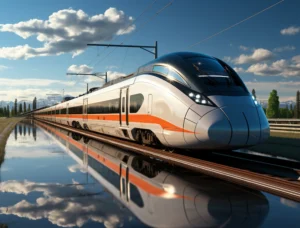7 Powerful Insights into the Growth of the Indian Economy

India’s Economy to Surge Despite Global Challenges: How it Continues to Outshine
The Indian economy stands as a beacon of resilience, continuing to grow steadily despite global economic headwinds. As the world battles economic uncertainties, India’s growth remains robust, driven by a mix of public infrastructure investment, private consumption, and evolving trade dynamics. This article takes a closer look at how the Indian economy navigates the challenging global context, the key sectors driving growth, and the factors that make India a fast-emerging economic powerhouse.
The Indian Economy: An Overview
The Indian economy has been one of the fastest-growing major economies globally, maintaining a growth rate of over 6% in recent years. The World Bank, in its latest India Development Update (IDU), observed that India’s growth for FY23-24 stood at a remarkable 8.2%. This growth was not a result of isolated factors but a combination of public investments, household consumption, and a flourishing manufacturing sector. Despite global slowdowns, India’s economy has managed to maintain its momentum, projecting a positive outlook for the future.
This dynamic growth has been supported by several factors, such as the government’s focus on infrastructure projects and policies aimed at boosting both domestic and foreign investments. India’s manufacturing sector has seen significant growth, with a year-on-year increase of 9.9% in FY23/24. Furthermore, strong service sector performance and improvements in urban employment have contributed to overall economic expansion.
The Role of Private and Public Investments
One of the defining features of the Indian economy is the strong role of public and private investments in driving growth. Public infrastructure development, especially in sectors like railways, highways, and energy, has given the economy a much-needed boost. These projects not only enhance the country’s long-term growth potential but also create jobs, stimulating economic activity across various sectors.
Household consumption also plays a vital role in the economic landscape. India’s real estate market, for instance, has seen an upswing, with more households investing in properties. Real estate development has been a key driver of urban employment, particularly for female workers, whose participation in the workforce has grown over the past few years. As a result, female urban unemployment dropped to 8.5% by early FY24-25.
The Resilience of India’s Foreign Exchange Reserves
India’s economic stability has been further reinforced by a robust foreign exchange reserve, which reached an all-time high of $670.1 billion in early August 2023. These reserves provide a strong buffer against external shocks, ensuring that the Indian economy remains resilient in the face of volatile global conditions. The accumulation of reserves has been facilitated by a narrowing current account deficit and increased foreign portfolio investment inflows, positioning India favorably in global markets.
Global Trade and India’s Growth Prospects
The importance of trade cannot be overstated when discussing the Indian economy. Trade, both imports and exports, has played a critical role in boosting growth. However, the global trade landscape has undergone significant changes, particularly in the wake of the COVID-19 pandemic, which disrupted global supply chains and increased protectionist tendencies in many countries.
India, however, has turned these challenges into opportunities. By enhancing its global competitiveness through policies like the National Logistics Policy and several digital initiatives, India has been able to reduce trade costs and position itself better in the global trade arena. Although protectionist measures and trade barriers still pose challenges, India continues to diversify its export basket and integrate into global value chains. Sectors like textiles, apparel, footwear, electronics, and green technology products offer significant potential for increasing India’s trade share.
Achieving India’s $1 Trillion Merchandise Export Target
The Indian government has set an ambitious target of achieving $1 trillion in merchandise exports by 2030. While this is no small feat, it is not unattainable. To meet this goal, the country needs to continue lowering trade costs, further reducing tariff and non-tariff barriers, and deepening trade integration with global markets.
The World Bank’s IDU has outlined a three-pronged strategy to help India achieve this target:
- Reducing trade costs: By continuing to streamline customs procedures and improve transportation infrastructure, India can make its exports more competitive globally.
- Lowering trade barriers: Reducing tariffs and non-tariff barriers will help Indian companies tap into international markets more effectively.
- Deepening trade integration: By becoming more integrated into global value chains, India can boost its export potential and generate more trade-related employment opportunities.
The Manufacturing Sector: A Cornerstone of the Indian Economy
India’s manufacturing sector has played a pivotal role in driving the country’s economic growth. In FY23/24, the sector grew by an impressive 9.9%, reflecting its potential as a key driver of the economy. India’s Make in India initiative and related policies have encouraged domestic manufacturing and attracted foreign investments, resulting in the creation of more jobs and increased output.
Sectors such as textiles, footwear, and electronics have significant growth potential, especially as global supply chains shift and businesses look to diversify their manufacturing bases away from China. India’s competitive advantage in these industries positions it to become a key global player in the coming years.
Services Sector and Its Role in Economic Growth
While the manufacturing sector is vital, the services sector continues to be the backbone of the Indian economy. This sector, which includes information technology (IT), business process outsourcing (BPO), and financial services, has contributed significantly to India’s growth story. India’s IT sector is one of the largest in the world, providing a broad range of services to businesses globally and driving substantial foreign exchange inflows.
In addition to traditional services, India is also making strides in newer fields such as green technology, which has the potential to significantly impact its future economic landscape. With global focus shifting toward sustainability, India’s green tech innovations can play a crucial role in driving both domestic growth and international trade.
Challenges and Opportunities for India’s Economy
Despite its impressive growth, the Indian economy faces several challenges. Rising production costs, declining productivity in some sectors, and the lingering effects of the global pandemic have created obstacles. For example, India’s share of global apparel exports has declined from 4% in 2018 to 3% in 2022, largely due to increased production costs and competition from countries like Bangladesh and Vietnam.
However, these challenges also present opportunities. India can integrate more deeply into global value chains, which will not only help address these challenges but also create avenues for innovation and productivity growth. The government’s focus on improving infrastructure, reducing trade costs, and boosting investments is likely to yield positive results in the medium to long term.
The Future of the Indian Economy
The World Bank and the International Monetary Fund (IMF) both project strong growth for the Indian economy in the coming years. The World Bank recently raised its growth forecast for India to 7% for FY24-25, citing strong private consumption and investment as key drivers. Similarly, the IMF revised its growth projection for India’s GDP to 7%, signaling optimism about the country’s economic trajectory.
India’s real GDP growth, while slightly lower than previous years, remains robust. According to the Ministry of Statistics and Programme Implementation, India’s GDP grew by 6.7% in the first quarter of FY24-25. While this figure reflects a slight decline compared to the 8.2% growth in FY23-24, it is still impressive given the global economic environment.
India’s Path to Economic Success
The Indian economy is well-positioned for sustained growth, despite global challenges. Its combination of strong domestic consumption, a growing manufacturing base, and a thriving services sector provides a solid foundation for continued expansion. As India continues to diversify its exports, lower trade barriers, and deepen its integration into global value chains, it has the potential to become a major player on the global stage.
India’s future success will depend on its ability to adapt to changing global conditions, reduce trade costs, and invest in both human and physical capital. With the right policies and continued investment in key sectors, the Indian economy is poised to remain one of the world’s fastest-growing economies for years to come.




1 thought on “7 Powerful Insights into the Growth of the Indian Economy”